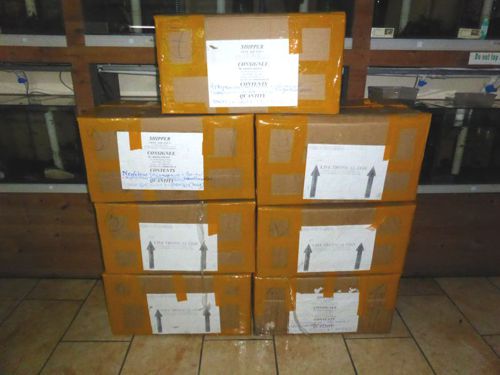
Cameroon
Import - December 2022
Tim Addis

The beauty of writing on a web page is
you can go back & update the piece. So will be the case with this article.
Fish take time to come back into condition & I will add more photos as they
mature.
|
Being 'in the trade' we have all the right contacts
& the ability to freight in boxes of fish worldwide. Whilst we have
imported killies from Guinee, Nigeria & Congo we had not done Cameroon
for many years. As with other African imports this takes time to organise
& collect. Although it looks glamorous to be able to import boxes
of killies from West Africa, believe me it's hard work. Firstly you
have to vet potential collectors because it's easy to get scammed especially
as the fishermen don't do anything unless they get paid in advance.
Packing the fish is really hit & miss. This shipment was not the
best & it had a fair proportion of DOA's due to various factors
like not purging the fish before bagging, cancellations by the airline
which meant fish being held couldn't go soon enough & a heatwave
in Cameroon at the time.
The first contact we had asked for money up front which is usual with these shipments but proved too difficult to work with, asking more than the fish would have cost. So, we tried another old contact who gave us an impressive list of available fish. A lot of negotiations later & the collector sent his fishermen out to start collecting. We would have liked fish from the Nigerian border area but their was a war going on in the area between the border & Mount Cameroon which made it too dangerous to fish. Plenty of fishing could be done south of the mountain. Another species we wanted was Fp.kribianus. In previous years we had them from Fifinda but the fishermen couldn't find them here as a plantation of banana had been created. The main area of collection was west of Douala towards Moliwe where they caught Pelvicachromis kribensis (formerly taeniatus), then up to Buea & along the eastern slopes of Mount Cameroon. This is A.poliaki territory & they advised a location as Muea which I thought to be a spelling error until I found a small village called Muea near the slopes. A little further north & the range of A.poliaki comes to an end, being replaced by A.volcanum. These were collected at Muyuka along with Procatopus similis. These were pale blue in the body & yellow margins to unpaired fins. This was an interesting bag as it also contained A.ahli which was fortunate as the A.ahli bag came in with a bacterial type infection which we found very difficult to treat & subsequently lost the bag. Also, some Epiplatys with green eyes which I initially thought to be E.grahami but may turn out to be E.infrafasciatus.
Further along this road they collected at Yabassi. Here was mainly Procatopus with a red/yellow striped anal fin. Also collected were 14 A.riggenbachi.
A.exiguum was also collected. They collected a Chromaphyosemion sp at Mabanda (which was marked on the bag). There is also a Mbanda on the route back to Douala.On this route back they collected a Chromaphyosemion sp. at Penja but all this bag came in DOA. Also collected were Neolebias trewavasae, Atya shrimp, Eremius camptacanthus barbs. To date we have managed to get eggs from A.riggenbachi. I have had this species a few times but never did very well with them. This time the fish were put in a 2 foot square tank on system which had a good flow of water about pH 7 & 1-2 GH. The turnover of water seems to do the trick with these & may be the trigger in getting them to spawn. They can lay around 10 eggs a day. They seem to be sexing out at 3 pairs. To give you an idea on costs, these cost around £26 a pair to bring in. I also had eggs of A.poliaki Muea after 3 weeks. This is an aggressive species & males will fight. Whilst I would have liked to make fish available sooner, this is not really possible with killie imports. Chromaphyosemion are usually small, thin & ragged & need some time to build back up. This import had its share of problems with infections from bacteria, fungus & parasites. All need cleaning up & you get the inevitable casualties along the way. I will continue to get killies in for group members & make them available in either fish form or eggs as I can. |